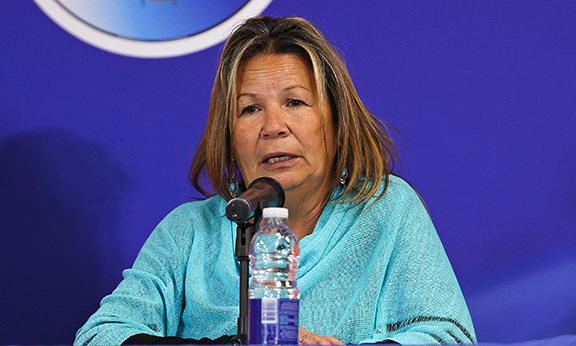The new Orange Standard is a redesign of child well-being

By Kelly Anne Smith
NORTH BAY- With the commitment to a new Orange Standard, Niijaansinaanik Child and Family Services starts the journey of establishing a new approach to providing Indigenous Child, Youth, and Family Well-Being services. The launch of the Orange Standard Service Delivery Model took place October 18 at the Best Western in North Bay.
“It really is bringing the level of service delivery to a higher level than national standards,” says Joanne Koelher, the Executive Director of Niijaansinaanik Child and Family Services. “And when you think of standards of excellence, a lot of people think of the gold standard. And that’s where we wanted to remain in line with Indigenous familiar language. That’s the Orange Standard.”
In 2016, Waabnoong Bemjiwang Association of First Nations was mandated by jurisdictional Chiefs to develop a First Nations Children Services Agency for the member First Nations of Dokis, Henvey Inlet, Magnetawan, Shawanaga, Wahnapitae, and Wasauksing. Niijaansinaanik Child and Family Services head office is in Dokis First Nation.
The Indigenous agency offers alternative care, child protection, customary care, kinship and prevention services. Cultural services such as Sweatlodge Teachings and ceremony are available as well as family support services. The four pillars guiding care are: the rights of the child, First Nation child and family funding equity, Niijaansinaanik history, heritage and culture, and an “Every Child Matters” framework of operational excellence.
Koelher says the new Orange Standard began while reviewing annual strategic planning.
“The Orange Standard is something that will demonstrate our commitment to our communities that we are fully in tune and focused with service model delivery excellence.”
“From now until March 31st, we’ll be developing this framework. Developing the framework will be involving the communities, for them to have a say on how they want to be serviced. Next year will be implementing it. That will include outreach and engagement with our First Nations. It’s fine-tuning those levels of services and incorporating the voice of the community, the voice of the child, the voice of the Elders, into how we redesign our current service model.”
The Orange Standard will break the colonial mold of child welfare says Koelher.
“Historical colonial care in Canada is very much represented by our history: The Sixties Scoop, Residential Schools, and how services were provided to Indigenous children and families. When we [Niijaansinaanik Child and Family Services] provide Indigenous services to children and families, we do so from a culturally congruent perspective. When we meet with families, we will meet in circle. We provide ceremonies to families. We provide cultural resources to families. That is the break from the colonial perspective of service delivery.”
Koelher adds the Orange Standard proposal to the federal government was very well received, even though they are going through negotiations for the new Agreement-in-Principle and funding reform.
“We are hoping moving forward as we develop this framework that we are funded to continue on to develop the Orange Standard model that we want our families to benefit from. It’s something that’s not only for Niijaansinaanik. We are open to engaging with other Indigenous agencies; open to engaging other like-minded service delivery organizations that provide services for Indigenous children, youth, families and communities.”
Niijaansinaanik Child and Family Services invites communities that are exercising their right to utilize Bill C-92.
“We would be very open to them joining us, looking at the model we are developing and lending from it to do their own servicing. This is not a model that Niijaansinaanik owns. It’s something that we are creating and developing that we will use to service our children and youth and communities and we will be open to sharing that model.”
The Truth and Reconciliation Commission, as part of Calls to Action, called on governments to commit to changing the child welfare system to reduce the number of Indigenous children in care.
In 2016, an Ontario Human Rights Commission (OHRC) inquiry found that over half of children under age 15 in foster care in Canada were Indigenous, despite Indigenous children being only 7.7% of the child population.
The OHRC also found that more than 40% of children aid societies did not know the racial backgrounds or Indigenous identities of more than one in five children. Four agencies didn’t know the Indigenous identities of over half the children placed into care.

